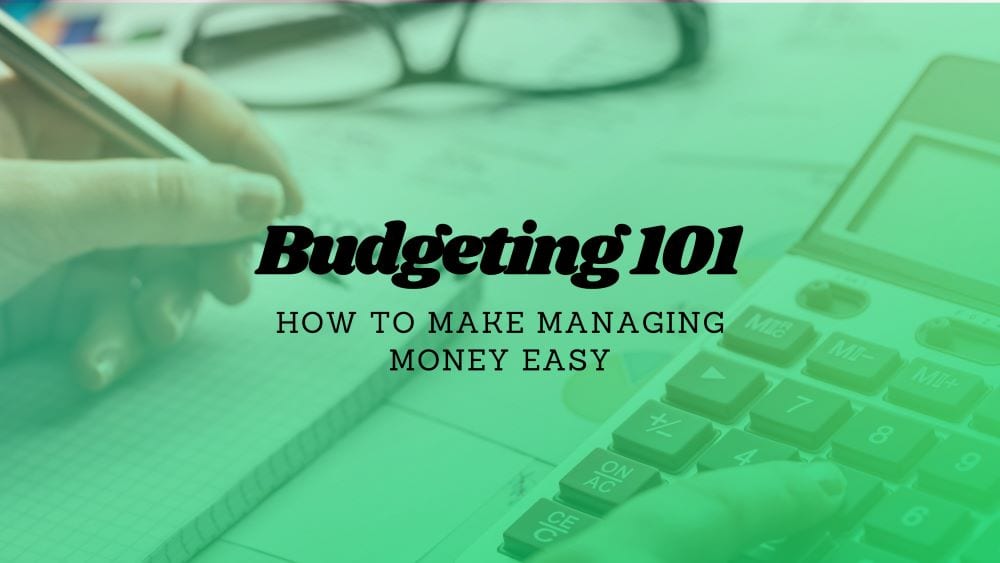
5 Steps to a Successful Budget
As an Amazon Associate I earn from qualifying purchases. We may earn money or products from other companies mentioned in this post at no cost to you!
Reading Time: 8 minutesWelcome to Budgeting 101! This will be your how-to guide to budget creation.
Budgeting is really simple, in my opinion. It’s “spend less than you make”. For most people, though, that simplistic of an approach to budget creation doesn’t work well.
I want to help you and show you how to budget in way that will make you successful. Yes, it is simple, but can be kind of involved upfront. In this post, I’m going to concentrate on the creation of your budget, and then do a separate post on how to stick to it.
So, do I really need a budget?
Yes, I know people don’t want to hear it, but I would say that pretty much everyone needs a budget. I can’t think of someone who doesn’t.
I try to write about these not-so-exciting topics as I would try to explain this to a friend. Before I get to the “how to do it”, let’s understand the “why” of budgeting.
I liken this to exercising. Exercising regularly and consistently is good for your overall health, and can have some positive physical benefits, too.
Budgeting is like exercising for your finances, contributing to your financial health, and can have some positive physical benefits, too! The physical benefits are that you’ll have the means to do things like buy a house, travel, buy a new car, etc. It may not seem like it, but you really can have have these things on any income. The way to get there is through budgeting.
Getting started on your budget
Before you even start putting numbers to paper (or excel), the first thing you need to do is to try changing your mindset about budgeting.
Think of your home and your finances like it’s your business, like your own little company. Creating your budget is like setting a roadmap or goals for where you want your business to go. What budgeting does is allocates your resources (your income) for necessities and other priorities.
YOU get to decide where it goes. YOU are the President, CEO, and CFO of your household, and preparing your budget is darn important! You’re making sure that your family ends the year with a profit instead of a loss.
Instead of thinking of budgeting as an unpleasant chore, get excited about where you get to go when you have your finances under control!
Got the right mindset? Okay, now on to the actual numbers part of budgeting.
Step #1: Necessary and non-fluctuating expenses
My budgeting method will help you set up a budget regardless if you have a steady paycheck or irregular income. This method manages to the expense side instead of the income side.
What I mean by that is you should first write out all your regular monthly expenses: rent/mortgage, average utility bills, etc. and make that your baseline.
The reason I do it this way is because people typically would use their income and start budgeting with that as their baseline.
First of all, that is harder to do when you have an irregular income; and secondly, allocating funds based on how much you make and not how much you actually need to spend can lead to lifestyle creep (you know, the tendency to spend more when you get a raise) when your income increases. I’m trying to get you to start at the bare minimum and build up from there.
So, in this step, I want you to write down your monthly expenses that are necessary and don’t change from month-to-month. That would be your rent/mortgage, phone, internet, etc.
Don’t forget to budget for insurance if you pay it annually or semi-annually.
Be sure you’re using the actual amounts and not just guessing- people tend to underestimate, and you really should have a handle on what you’re paying for things.
Step #2: Necessary but changing expenses
Next, I would move to the fluctuating but necessary expenses, like utilities, gas for driving, and groceries. You may have to do a little more research in this step because you should be writing down an average of these items for each month. These amounts won’t be exact every month but you want to be sure that you’ll have enough for them each month.
Try to be as realistic as possible. I recommend going through your last three months of spending and find your average that way.
In this step, do NOT include all your miscellaneous dinners out, coffee, and other shopping. Also, do not include debt payments in this.
After you’ve done these two steps, now you know what is your bare minimum that you need to spend to survive.
Step #3: How is that budget looking so far?
This step could be a big one because it could get pretty involved, depending on your situation.
In this step, do a quick check to see how your expenses line up to your income. My rule is that your expenses shouldn’t exceed 70% of your after tax income.
For those that get a regular paycheck, this is called “net” on your paycheck. If you have an irregular income, try averaging your last six months of income.
If you don’t meet that 70% threshold, don’t beat yourself up. Maybe you’re in a situation where things are tighter right now. Fixing that would be a topic for a different post so let’s stick to budgeting right now.
If your income still exceeds your living expenses, you’re done with this step!
However, if your expenses are higher than your income, you have other work to do. You should take a look at your necessary expenses and see what you can cut out.
For instance, if you included a gym membership in Step 1 because it was a recurring monthly expense, take that out. While it’s a good thing if you’re actually using that membership, it doesn’t meet the definition of “necessary” to your living situation. You may need work out at home instead until you can afford the gym.
Also, groceries are one of the most controllable expenses, and probably that hardest to actually control! Check out this post from Budgetology to get some tips to save on groceries.
Again, don’t want to get too bogged down on this subject, but other ways to bring this in balance is you could take on a roommate or move to a different area to reduce your housing expense, which is typically one of the largest expenses for any household.
Examine your bills to be sure they’re accurate, because maybe you have a water leak and your water bill is higher than it should be. Or your cell phone is charging you for things you don’t remember subscribing to, or change your cell phone all together because you can’t actually afford it. Here’s a great article by Rinkydoo Finance about living below your means to help you out. But do something!
If you didn’t have to try to cut expenses in this step, it’s a pretty simple one for you. Assuming you’ve brought this in balance or you’re already in good shape, proceed to the next step.
Step #4: Budget for savings or pay off debt?
This step is where your money goes one of two ways: savings or paying off debt.
For savings, if you don’t have debt but have an irregular income, you could make savings a percentage of your net pay or something like that. For those with regular paychecks, look at the 70% rule above. That 30% after-tax cushion that’s not going to living expenses should be going towards savings of some kind (See my post about the different savings accounts you need here ).
Whatever your income situation is, no matter what, it’s important that you budget savings before all your miscellaneous spending or it just won’t happen. Trust me, you won’t do it. You’ll spend all your leftover money, it’s really easy to do, and then you won’t have money for savings.
Recognizing this doesn’t make you a failure and is not something you should be ashamed about. I’ve heard enough people say “Of course I’ll have money left over and will put in savings”, like they’re too prideful to just acknowledge that they won’t unless they plan up front. If you hear yourself saying something like this in your head, just do yourself a favor, trust the process, and put it in your budget to set the savings aside now and live off the rest after that.
Okay, so what about debt? If you do have debt, your first priority should be paying that off.
After you’ve used the methods here to set aside enough savings for emergencies, start itemizing your debt payments and use that money that was for savings to pay off your debt as soon as possible. (I have other posts about paying off debt so won’t dive into the process here- I could go on for a very long time!)
The simple way of budgeting for these expenses is don’t just budget the minimum payments or you’ll just tread water forever. Budget as much as you can towards paying off your debt.
If you’re wondering why debt is not included in the monthly expenses above even though debt is an obligatory payment and usually the same amount every month, it is because debt is not an expense that I would say is not necessary to living.
I ordered the steps this way so you figure out all your living expenses first to understand what it is that you really need to survive. I feel it’s a good practice for you to understand how much more money you’d have available to you if you weren’t having to pay off debt.
A car loan is not necessary to survive. You can (yes, really, you can) find decent cars under $5,000. Credit card debt is also not necessary to survive. You need to eliminate these as soon as you can! In theory, the money you budgeted for savings would actually go towards paying off debt until it’s all paid off.
Here again, after plugging in your debt payments, if your expenses exceed your monthly income, stop here. While not necessary to survive, you DO need to be able to pay your debt so go back, reevaluate where you need to cut expenses, because we still haven’t even gotten to miscellaneous spending.
Step #5: The fun part!
Assuming you get to this point and you still have money left over, now you can finally decide how to spend your money for fun!
Take a look at what you’ve been spending on things that don’t fit in the above categories and come up with an average. This is going to be your Home Depot purchases, hair cuts, gym memberships, make-up subscriptions, taking the family out to the movies on the weekend, going out to happy hour with co-workers, etc. Budget amounts for date nights and other things like that, too.
When you have an amount figured out, lump these things together in a “miscellaneous” category. These things are non-recurring and don’t have a pattern of how much they will cost each time.
Don’t know about you, but I could spend $5 or $500 dollars at Home Depot easily. This category may be limited by how much you have left after your necessary and obligatory expenses, but can also be limited by how much you’re willing to spend.
Maybe you’ll decide that you can actually put more in savings!
Whatever that number may be, make sure you stick to it. In my example of $500 at Home Depot, that’s probably a big enough expense that it’s something I should save up for ahead of time. But if I spend $150 there, and my miscellaneous budget is only $150, well, then, I guess I’m done until that new budget period starts.
Having the miscellaneous category is really important because your budget needs to have flexibility.
What if you have utilities be less one month than what you estimated in your budget? Go ahead and shift that extra to your miscellaneous! Or you spend more on gas for whatever reason, you can shift money from your miscellaneous category to make up the difference.
Another reason for a catch-all miscellaneous category is because it would be exhausting and overwhelming to have a category for every little thing.
At the end of a budget period, if I still have leftover money in any category, I tend to roll it over into the next budget period. I do this because I’ve already budgeted my money into savings so any extra should go towards miscellaneous items, like car parts, new vacuum, etc. By doing this, I don’t have to dip into my emergency savings or regular savings for those kinds of things.
Final guidance
Well, you’ve done it! You should have a working budget now.
The last thing to do is more of a mental practice than a physical task. Your unofficial last step will be maintaining the new budget that you’ve set up.
If you don’t follow it perfectly right away, don’t give up on it! Tweak it if you need to. Or, practice some discipline if that’s what you need to do. 🙂 Sticking to a budget might involve changing some behavior so having the right mental attitude is key to making your hard work actually pay off (literally!) for you.
Don’t forget, you’re the President/CEO/CFO of the business of you and/or your family, and you have a responsibility to make sure you are successful.
RELATED:
See this post about using multiple bank accounts to help you stick to your budget.
See this post about using your budget to build your savings!
IF YOU WANT TO SEE MORE…
Consider subscribing to my e-mail list. You can always unsubscribe, I won’t spam you!
Follow me on Facebook, Instagram, or Twitter.
Save this post on Pinterest by using the share buttons, and follow me, too!
If you want to start a blogging business, check out this FREE course!
If you want to make money from a blog, check out this program that got me started making my own money blogging!





2 Comments
Jennifer
Excellent post. I myself am taking a bit-by-bit approach. A little bit of debt payoff, a little bit of investing, and A LOT of saving for bigger purchases, cough cough, house down payment. 😎
Ashley
I’m a big believer in using a system that works for you (as long as it IS working) because it’ll be easier for you to stick to. Keep it up!